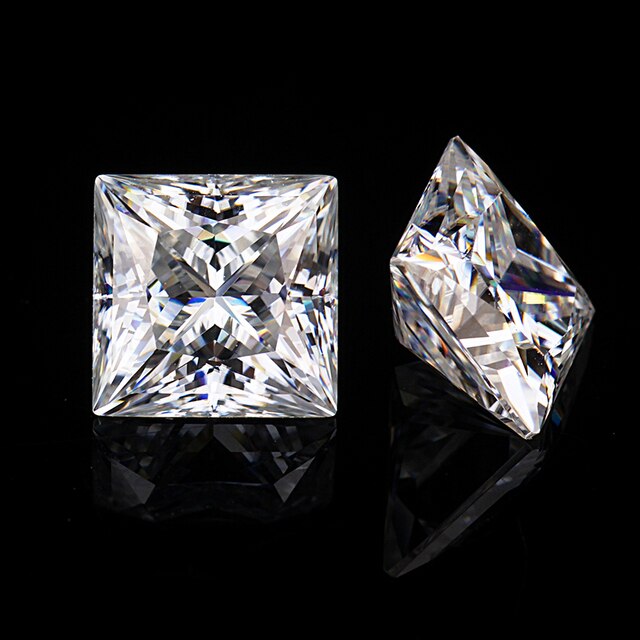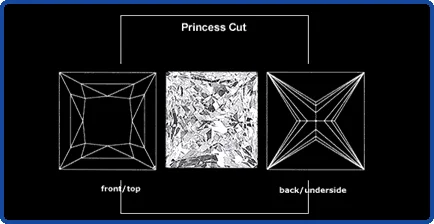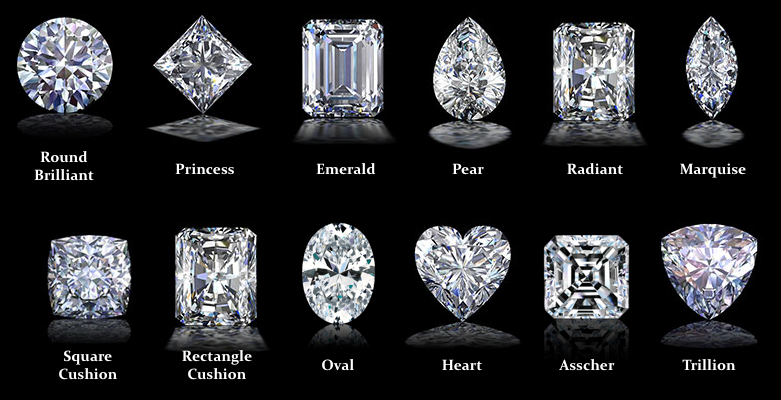Princess Cut Diamond
Princess Cut Diamond

- Princess cut diamonds continue to be one of the most popular diamond shapes. They are elegant and full of sparkle. You cannot go wrong with them, especially if they are well-cut and set in a beautiful halo setting.
- Since the GIA does not assign a cut grade to princess cut diamonds, you must have a basic idea of the ideal proportions for a princess cut diamond to make an informed decision. Ideally, a depth of 62-74% and a table of 58-70% is preferred. Follow our chart below carefully for a thorough examination.
- It is necessary to know what you prefer in terms of the length-to-width ratio when it comes to princess cut diamonds. Do you want a square or a rectangular cut diamond? We have provided ideal ratios for both options below. Make sure you follow them while making a purchase.
- Princess cut diamonds have sharp corners and hence can be susceptible to chipping if left unprotected. Ensure that you set them in secure prongs; we prefer the v-prongs, provided you do them correctly.

Princess Cut Diamond Overview:
Betzalel Amber and Israel Itzkowitz popularized the fancy “French” inspired cut diamond in the 1970s. Princess cut diamond is our most popular non-round diamond because of its brilliance and unique cut, making it a favorite diamond for unique engagement rings.
Princess cut diamonds have pointed corners and are traditionally square cut. We use the term “traditionally” because many princess cut diamonds are slightly rectangular. The preciseness of how the stone is cut into a square affects the price of the diamond. However, many consumers prefer a rectangular cut; often, it is about how you want your diamond to be. As shown in the picture below, rectangular princess cut diamonds have a distinct advantage over a square princess cut diamond—they look larger (both of the following princess cut diamonds weigh one carat). If you have slim fingers, a rectangular princess cut diamond might be the choice for you.
In addition to providing you comprehensive insights on the 4Cs of princess cut diamonds, we will also cover four scenarios in this article that you should consider while deciding which C to compromise on and to what degree.
The key factors to consider while buying a princess cut diamond include the cut, color, and clarity. Learning more about diamond fluorescence and certification is also a good idea.

Analyzing the Cut of Princess Cut Diamonds:
Princess cut diamonds do not have an assigned cut grade in the grading reports of the GIA. However, the AGS does assign a cut grade to princess cut diamonds. A full agreement as to the proportions of the princess cut does not exist. It is indeed a conundrum for many suppliers and consumers of princess cut diamonds.
If you would like our view on it, we think you should look for a diamond whose total depth is 68-70% (with a tolerance of 5%). Another rule of thumb is to check that the diamond’s polish and symmetry grade is Good.
Generally, the diamond’s brilliance is maximized by how nicely it has been cut without making the diamond look too deep or too shallow. Please follow the chart guide below for determining the cut of a princess cut diamond.
|
Depth % Excellent: 64-74.9 Very Good: 64-74.9 Good: 59-64/75.5-81 Fair: 56.5-84 Poor: <54 or >84 |
Table % Excellent: 62-69 Very Good: 58-61/71.1-73.9 Good: 55-59/75-81 Fair: 55-81/52-85.3 Poor: <52 or >87 |
|
Crown Height % Excellent: 10-16 Very Good: 9-15.5 Good: 6-17.9/8-17 Fair: 5.2-18/4.1-20 Poor: <3.2 or >21 |
Girdle Excellent: Very Thin-Slightly Thick/Thin-Thick Very Good: Very Thin-Slightly Thick/Thin-Thick Good: Very Thin-Thick Fair: Very Thin-Very Thick Poor: Extremely Thin-Extremely Thick |
|
Culet Excellent: None Very Good: Slight Good: Small Fair: Average Poor: >Average |
|
|
Length/Width Ratio: Square Range Excellent: 1.00-1.05 Very Good: 1.00-1.05 Good: 1.00-1.05 Fair: 1.059-1.079 Poor: >1.079 |
Length/Width Ratio: Rectangular Range Excellent: 1.26 -1.45 Very Good: <1.20 – >1.50 Good: <1.18 – >1.55 Fair: <1.15 – >1.65 Poor: >1.70.00 |
The chart above represents a set of guidelines created for you to use as a rule of thumb when evaluating the cut of a princess cut diamond. We would advise you to avoid a princess cut diamond whose depth percentage is smaller than its table percentage.
Choosing the Color of a Princess Cut Diamond:
H Color or I Color in a princess cut diamond will give you more value for your money, although the higher the color, the better the diamond is. One thing to look for when evaluating the color of a princess cut diamond is to find a diamond that does not have a visible yellow tint. For that reason, you will be better off if you do not choose a color grade lower than G, H, and/or I.
It is not essential to spend additional money to buy a colorless princess cut diamond, i.e., the ones graded as D, E, and/or F. Any of these colorless grades will not have a conspicuous difference in color with the naked eye as, say, I or J colors. G and H color diamonds are also considered relatively high-quality stones and should be a top option for people with budget constraints.
Selecting the Clarity of a Princess Cut Diamond:
We like princess cut diamonds because of their proportions and ability to, unlike other diamond shapes, exhibit significant brilliance and sparkle. This is a valuable aspect of princess cut diamonds because the brilliant proportion makes a diamond’s inclusion less visible.
Although princess cut diamonds with clarity lower than SI1 are rare, you may still find your dream princess cut diamond if you focus on buying a diamond with VS1, VS2, SI1, and/or SI2 graded clarity.
One thing to pay attention to when buying these sparkling diamonds is to make sure that the diamond you choose does not possess visible inclusions in its corners. Large inclusions lead to weakened corners, which then makes the diamond susceptible to chipping.
Selecting the Right Setting for a Princess Cut Diamond:
Always choose a setting that protects the diamond’s corners. When a diamond is set in a mounting with rough edges, it causes the diamond to thin. Besides, a strong blow can also eventually chip the diamond off.
To provide a safe mounting for your diamond, choose a V-prong setting.
Best Scenarios to Consider While Buying a Princess Cut Diamond:
Consider these four scenarios while invest for a princess cut diamond.
After selling diamonds worth millions, we have accumulated four scenarios that customers prioritize when buying a princess cut diamond.
Scenario 1: The priority of the buyer is to get the highest color, clarity, and cut grade for any given carat weight. The following two stones would fit this criterion (investment-grade highest quality diamonds, Flawless to VVS, D-E color, GIA graded, No Fluorescence):
Scenario 2: In this category, the customer is still interested in a high-quality diamond yet wants to get a bigger stone (we call this high circulation and high-value stones because these are the most traded diamonds online). So, the customer would go as low as VS clarity and G/H color diamond, very good to cut excellent cut, medium blue fluorescence, and 1.5 carats instead of 1 carat.
Scenario 3: In this scenario, the customer is willing to go as low as possible to get an eye-clean stone with a decent color and the largest possible size. Therefore, they would go for a 2 carat, SI1/SI2, up to J color, up to strong blue fluorescence, and would even consider IGI/HRD certification. If you are in this category, make sure that you master diamond clarity because knowing which inclusions to avoid and which ones could work in your favor can make all the difference.
Scenario 4: The customer knows that he/she must compromise heavily on 1C to maximize on the other 3Cs. In this category, we usually recommend giving up on color to maximize the cut, carat weight, and clarity. The stone will look slightly yellowish (warm color might be your preference) but would still have optimal brilliance and fire because of the cut, high clarity, and big size.
Good Budget Options for Princess Cut Diamonds:
Princess Cut Diamond Options for Buyers with Budget Constraints.
Excellent Choice:
- At least 1.0 carats in Weight
- Very Good to Excellent Polish and Symmetry
- G or above in color
- SI1 or above in clarity
- No Florescence
- Length/width ratios: 1-1.05 for square or 1.5-1.75 for rectangular shape
Very Good Choice:
- At least 0.90 carats in Weight
- Good to Excellent Polish and Symmetry
- H or above in Color
- SI2 or above in Clarity
- None, faint or medium blue florescence
- Length/width ratios: 0.95-1.05 for square or 1.5-1.75 for rectangular shape
Good Choice:
- At least 0.80 Carats in Weight
- Good to Very Good Polish and Symmetry
- I or above in Color
- SI2 or above in Clarity
- None, faint or medium blue florescence
- Length/width ratios: 0.95-1.05 for square or 1.5-1.75 for rectangular shape
FAQ About Princess Cut Diamonds:

Are princess cut diamonds popular?
Yes, they are popular among shoppers that are looking for alternative options to round cut diamonds. Although oval and cushion cut diamonds have been trending higher than princess cut diamonds lately, princess cut still is among the most popular diamond shapes. It is always a good idea to check some options locally before buying loose diamonds online.
Which one is better, a square or rectangular princess cut diamond?
It depends on your taste; we are equally divided when determining which one is better. If you have thin fingers, rectangular might be the way to go. They will also look bigger than square and might be slightly pricier as well. However, square shapes are generally more popular, and hence you will see more square options in the market than rectangular.
What is the difference between princess cut diamonds and radiant cut diamonds?
The radiant cut diamonds generally have cut-corners and slightly different faceting structures in terms of cut than princess cut diamonds. Follow our guide on radiant cut diamonds for detailed information.
Credit: Sharif Khan on 7th Oct 2021
